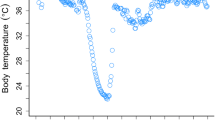Abstract
Energy metabolism of three sympatric swallows (Hirundinidae) was investigated during the breeding season using doubly labeled water (2H2 18O). Interspecific and intraspecific differences in energy metabolism were examined in relation to the habits, size and environment of the birds. To facilitate comparisons we expressed energy metabolism (M) as the ratio of average daily metabolic rate (ADMR, cm3CO2g -1h-1) to basal metabolic rate (BMR). We observed adults during incubation and when feeding nestlings. Then, both sexes of Sand Martins Riparia riparia and House Martins Delinchon urbica were either at the nest or on the wing. Incubation reduced activity levels during the day resulting in M (incubation) being 17–26% lower than during rearing. Differences in energy costs for rearing chicks depended mainly on flight behaviour, the smaller Sand Martin doing nearly twice as much flapping during flight as the House Martin, giving higher values for M. In Swallows Hirundo rustica the female incubates alone, alternating between short feeding trips and incubating in daytime. This pattern was linked with a relatively high value for M in the only individual behaving like our controls. Both sexes of Swallows feed the chicks, and they showed similar values of M. They also closely resembled House Martins, despite contrasts in the time spent flying and their behaviour during flight. Feeding conditions affected activity, and thereby M, in a species specific way. The House Martin did more gliding in poor weather, taking less mobile prey, reducing M. Swallows reduced foraging costs further by using body reserves, as in the House Martin. The smaller Sand Martin, in contrast, showed a high expenditure in poor weather. Over two breeding seasons ADMR reached values around 5 BMR for all three species.
Similar content being viewed by others
References
Asbirk S (1976) Studies on the breeding biology of the Sand Martin Riparia riparia in artificial nest sites. Vidensk Meddr Dansk Naturk Foren 139:147–177
Aschoff J, Pohl H (1970) Der Ruheumsatz von Vögeln als Funktion der Tageszeit und der Körpergröße. J Orn 111:38–47
Boyer PD, Graves DJ, Suelter CH, Dempsey ME (1961) Simple procedure for conversion of oxygen of orthophosphate or water to carbon dioxide for oxygen-18 determination. Anal Chem 33:1906–1909
Bryant DM (1975) Breeding biology of House Martins Delichon urbica in relation to aerial insect abundance. Ibis 117:180–216
Bryant DM, Turner AK (1982) Central place foraging by Swallows (Hirundinidae). The question of load size. Anim Behav 30:845–856
Bryant DM, Westerterp KR (1980a) Energetics of foraging and free existence in birds. Proc XVIIth Int Ornithol Congr Berlin 1978:292–299
Bryant DM, Westerterp KR (1980b) The energy budget of the House Martin Delichon urbica. Ardea 68:91–102
Bryant DM, Westeterp KR (1982) Evidence for individual differences in foraging efficiency amongst breeding birds: a study of House Martins Delichon urbica using the doubly labeled water technique. Ibis 124:187–192
Bryant DM, Westerterp KR (1983a) Short term variability in energy turnover by breeding House Martins Delichon urbica: a study using doubly-labeled water (D2 18O) J Anim Ecol 52:525–543
Bryant DM, Westerterp KR (1983b) Time and energy limits to brood size in House Martins (Delichon urbica). J Anim Ecol 52:905–925
Coleman FG, Manning RD, Norman RA, Guyton AC (1972) Dynamics of water-isotope distribution. Am J Physiol 223:1371–1375
Drent RH, Daan S (1980) The prudent parnt: energetic adjustments in avian breeding. Ardea 68:225–252
Friedman I, Woodcock AH (1957) Determination of deuteriumhydrogen ratios in Hawaiian waters. Tellus IX:553–556
Hails CJ (1979) A comparison of flight energetics in hirundines and other birds. Comp Biochem Physiol 63A:581–585
Hails CJ, Bryant DM (1979) Reproductive energetics of a freeliving bird. J Anim Ecol 48:471–482
Kendeigh SC, Dolnik VR, Gavrilov VM (1977) Avian energetics. In: Pinowsky J, Kendeigh SC (eds) Granivorous birds in ecosystems. IBI handbook no 12 Cambridge University Press, Cambridge, pp 127–204
King JR (1974) Seasonal allocation of time and energy resources in birds. In: Paynter R (ed) Avian energetics. Publ of the Nuttall Ornithological Club, vol 5, pp 4–70
Lifson N, McClintock R (1966) Theory and use of the turnover rates of body water for measuring energy and material balance. J Theor Biol 12:46–74
Lind EA (1960) Zur Ethologie und ökologie der Mehlschwalbe Delichon U. urbica Ann Zool Soc Zool Bot Fenn 21:1–127
Lohoefener RR (1980) Comparative breeding biology and ethology of colonial and solitary nesting barn swallows (Hirundo rustica) in east-central Mississippi. Unpubl Ph D, Mississippi State University
Morgan RA (1979) Sand Martin nest record cards. Bird Study 26:129–132
Mullen RK (1973) The D2 18O method of measuring the energy metabolism of free-living animals. In: Gessamen JA (ed) Ecological energetics of homeotherms. Utah State University Monograph Series 20:32–43
Nagy KA (1980) CO2 production in animals: analysis of potential errors in the doubly labeled water method. Am J Physiol 238:R466–473
O'Neil JR, Epstein S (1966) A method for oxygen isotope analysis of milligram quantities of water and some of its applications. J Geophys Res 71:4955–4961
Rheinwald G von, Gutscher H, Hormeyer K (1976) Einfluß des Alters der Mehlschwalbe Delichon urbica auf ihre Brut. Vogelwarte 28:190–207
Taylor LR, Palmer JMP (1972) Aerial sampling. In: Emden HF van (ed) Aphid Technology, Academic Press, London
turner AK (1980) The use of time and energy by aerial feeding birds. Unpubl Ph D thesis University of Stirling
Turner AK (1982) Timing of laying by swallows (Hirundo rustica) and sand martins (Riparia riparia). J Anim Ecol 51:29–46
Turner AK (1983) Time and energy constraints on the brood size of swallows, Hirundo rustica, and Sand martins, Riparia riparia. Oecologia (Berlin) 59:331–338
Vleck CM (1981) Energetics costs of incubation in the Zebra Finch. Condor 83:229–237
Walsberg GE (1980) Energy expenditure in free-living birds: patterns and diversity. Proc. XVIIth Int Ornithol Congr Berlin 1978:300–305
Waugh DR (1978) Predation strategies in aerial feeding birds. Unpubl Ph D thesis University of Stirling
Author information
Authors and Affiliations
Rights and permissions
About this article
Cite this article
Westerterp, K.R., Bryant, D.M. Energetics of free existence in swallows and martins (hirundinidae) during breeding: a comparative study using doubly labeled water. Oecologia 62, 376–381 (1984). https://doi.org/10.1007/BF00384270
Received:
Issue Date:
DOI: https://doi.org/10.1007/BF00384270




